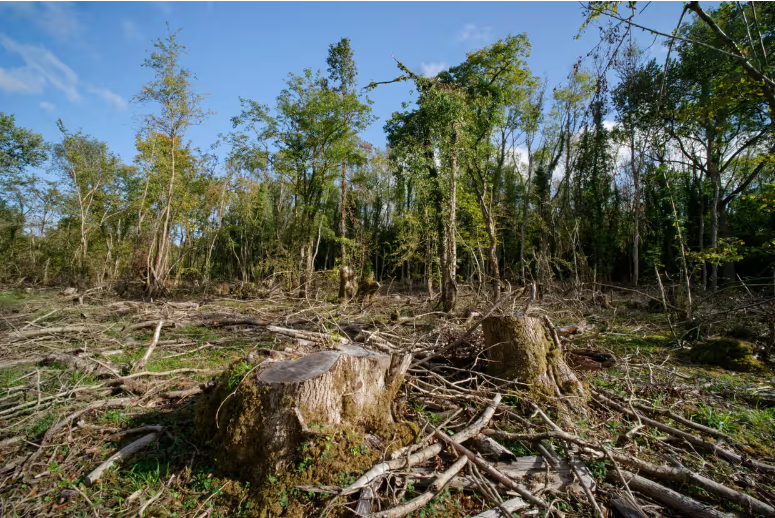
©Nick Upton/Alamy
Pre-reading questions:
I will read each question. Then, please answer them.
- What do you think are some common challenges or threats that forests around the world face today?
- How important do you think forests are in terms of their contributions to the environment and human well-being?
Vocabulary:
I will read the words, meanings, and sample sentences. Then, repeat after me.
- decline /dih-KLAHYN/
- collapse /kuh-LAPS/
- extensive /ik-STEN-siv/
- prompt /prompt/
- ambitious /am-BISH-uhs/
[noun] – when something becomes less in amount, importance, quality, or strength
Despite their efforts, the decline in sales was noticeable.
[noun] – a serious and sudden deterioration or breakdown
The collapse of the old bridge was a shocking event for the town.
[adjective] – covering a large area; having a great range
The extensive forest stretched for miles in every direction.
[adjective] – (of an action) done quickly and without delay, or (of a person) acting quickly or arriving at the arranged time
Despite the unexpected challenge, she gave a prompt response.
[adjective] – having a strong desire to achieve a challenging or significant goal
Despite the setbacks, he remained ambitious in pursuing his dreams.
Article reading:
Please read the whole article. Then, I will check your pronunciation and intonation.
A group of 42 experts and over 1,200 specialists have raised a serious alarm about the potential decline of British woodlands in the next fifty years, according to a study published in the esteemed Forestry journal. Dr. Eleanor Tew, a leading expert in forest planning, stressed the urgency of the situation.
Threats like diseases, severe weather, and wildfires are putting woodlands under significant pressure, with ash dieback disease being a significant risk, and winter storm damage in 2021 underlines the urgency of the issue. Climate forecasts predict an increase in extreme weather events, potentially leading to ecosystem collapse. UK forests are not yet in line with this scenario, but researchers recommend strategic measures like increasing tree species diversity, establishing mixed-age forests, and supporting natural regrowth. Additionally, vigilance against tree pests and diseases is crucial. The repercussions of an ecosystem collapse are extensive, affecting the availability of timber resources, carbon storage, air quality, water retention, and overall human well-being. Prompt and resolute actions are needed to safeguard these vital ecosystems. The seriousness of the situation is highlighted by instances of such collapses in certain European forests. The importance of proactive, forward-thinking forest management strategies cannot be overstated, especially considering the long time it takes for specific tree species to mature. The government’s ambitious plan to significantly increase forest planting is a commendable step in the right direction; however, concerted and sustained efforts are needed to change the current course.
Threats like diseases, severe weather, and wildfires are putting woodlands under significant pressure, with ash dieback disease being a significant risk, and winter storm damage in 2021 underlines the urgency of the issue. Climate forecasts predict an increase in extreme weather events, potentially leading to ecosystem collapse. UK forests are not yet in line with this scenario, but researchers recommend strategic measures like increasing tree species diversity, establishing mixed-age forests, and supporting natural regrowth. Additionally, vigilance against tree pests and diseases is crucial. The repercussions of an ecosystem collapse are extensive, affecting the availability of timber resources, carbon storage, air quality, water retention, and overall human well-being. Prompt and resolute actions are needed to safeguard these vital ecosystems. The seriousness of the situation is highlighted by instances of such collapses in certain European forests. The importance of proactive, forward-thinking forest management strategies cannot be overstated, especially considering the long time it takes for specific tree species to mature. The government’s ambitious plan to significantly increase forest planting is a commendable step in the right direction; however, concerted and sustained efforts are needed to change the current course.
Comprehension questions
I will read each question. Then, please answer them based on the article.
- Who raised concerns about the potential decline of British woodlands in the next fifty years?
- Where was the study about British woodlands published?
- What is ash dieback disease, and why is it considered a significant risk to woodlands?
- What event in 2021 highlighted the urgency of the issue of woodland decline?
- What are some of the threats putting woodlands under significant pressure?
Discussion questions
I will read each question. Then, please answer them.
- Have you seen how diseases or extreme weather affect local forests or woodlands? If so, can you share what you observed and any steps taken to help? If not, what steps do you think could be taken to actively contribute to the protection of these vital ecosystems?
- Have you been part of projects to protect forests or manage woodlands sustainably? If yes, what did you do, and what did you learn? If not, what might inspire you to join such projects in the future?
- Do you think it’s important to safeguard British woodlands, considering their role in resources and a healthy environment?
- What lessons can people learn from the potential problems facing British woodlands? How can these lessons apply to protecting forests and woodlands in your own country?
- With the potential challenges facing British woodlands, how might this situation prompt a reevaluation of the relationship with nature and the value placed on preserving natural ecosystems? How can individuals and communities contribute to a more sustainable coexistence with the environment?